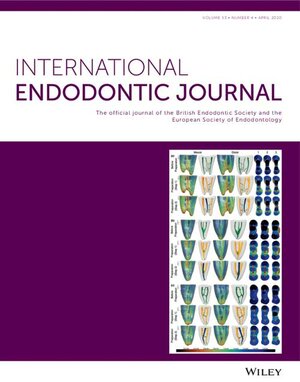Metallomic characterization of induced periapical lesions—In vivo study
Abstract
Aim
Metals are essential for metabolism and play a crucial role in various biological processes. Therefore, the aim of this study was to characterize and compare the metallomic profiles of periapical lesions and healthy alveolar bone in rats using complementary analytical techniques.
Methodology
This study included 76 lower first molars (from 38 Wistar rats) where induced periapical lesions and controls (sham) were compared. Periapical lesion induction was performed by pulp exposure of these teeth, allowing infection development. After 40 days, the animals were reweighed, euthanised and their hemimandibles analysed by periapical radiography, histological analysis, micro-computed tomography (μ-CT), X-ray fluorescence microscopy (μ-XRF), scanning electron microscopy with energy dispersive spectroscopy (SEM/EDS), inductively coupled plasma optical emission spectrometry (ICP-OES) and inductively coupled plasma mass spectrometry (ICP-MS). Ten essential metals for metabolism were analysed (sodium, potassium, magnesium, calcium, iron, manganese, cobalt, copper, zinc and molybdenum). The analyses observed a significance level of 5%.
Results
Radiographic analysis confirmed the induction of periapical lesions, without difference in animal weight between the conditions (p > .05). Histologically, the periapical lesions showed intense inflammatory infiltrate, cells with bluish cytoplasmic granules, alveolar resorption and scores ranging from moderate to intense. The μ-CT analysis of the induced lesion revealed a significant difference in the periapical region volume (12.74 mm3, p = .0017). SEM/EDS showed limited sensitivity for the investigated chemical elements; however, μ-XRF identified diminished intensities for calcium and zinc and increased intensities for iron. ICP-MS and ICP-OES identified increased concentrations of sodium (p = .0137), potassium (p = .0005), calcium (0.0059), magnesium (p = .0004), iron (p < .001), 56iron (p = .0078), 57iron (p = .0315) and manganese (p < .001) within the induced periapical lesion, suggesting a direct impact on mineral homeostasis following this pathology.
Conclusions
This study demonstrated differences in the levels of various essential elements between conditions with periapical lesions and healthy controls.


 求助内容:
求助内容: 应助结果提醒方式:
应助结果提醒方式:


